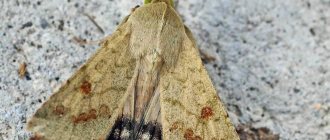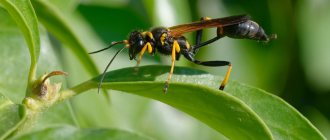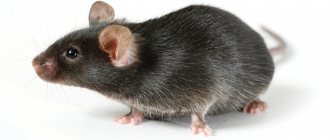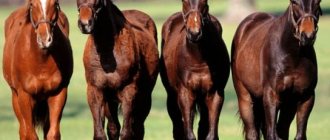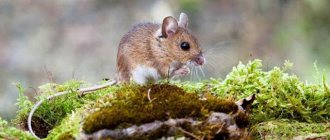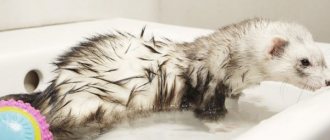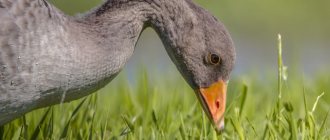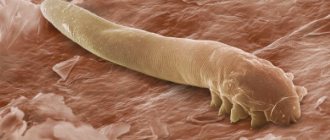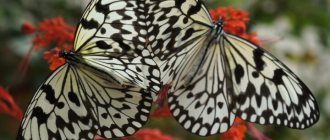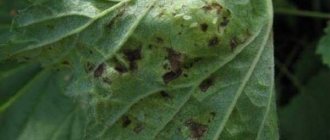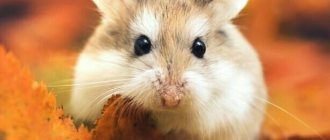The first two species are common in Eurasia, while the blackfoot is found only in North America. Domesticated ferrets are often called ferrets, freds or ferrets from the English ferret. According to the biological classification, ferrets, together with weasels, minks and ermines, belong to the species Mustela of the family Mustelidae (Mustelidae).
Steppe polecat
The largest representative of related species. The length of its body reaches 56 centimeters, the tail is up to 18 cm, and its weight is up to two kilograms. The animal's fur is characterized by a long and thin coat, through which the light underfur is clearly visible. It is distinguished by the darker color of the fur on the paws, the tip of the tail and the presence of a dark mask on the muzzle. It feeds on small rodents, large insects, frogs, and hunts snakes.
Detailed description of the breed: Steppe ferret
Forest polecat
Somewhat smaller than its steppe brother. The body length is up to 46 cm, the tail length is up to 16 cm, the weight of an adult is about 1.5 kg. Color varies from white and red to black. The most common color variant is black-brown, in which the belly, paws and tail are much darker than the rest of the body. Just like the steppe ferret, it feeds on rodents, mainly mouse-like ones, frogs, and hunts birds and snakes.
Detailed description of the breed: Forest ferret
Black-footed ferret
Found only in North America, listed in the Red Book. Almost completely exterminated in Canada and the USA. Now it is bred in captivity and released into its natural habitat. It is distinguished by its small body size and body weight of about 1 kg. The fur is thick, low, darkening towards the tips. The paws, the end of the tail and the mask on the face are almost black. The main food in nature are gophers.
Detailed description of the breed: Black-footed ferret
Types of ferrets
The breeds of ferrets and their colors are the subject of a long debate among zoologists and lovers of the domesticated form of these wonderful animals. Ferrets do not distinguish between breeds as such. There are currently three known species of ferrets living in the wild: steppe, forest, and black-footed.
The first two species are common in Eurasia, while the blackfoot is found only in North America. Domesticated ferrets are often called ferrets, freds or ferrets from the English ferret. According to the biological classification, ferrets, together with weasels, minks and ermines, belong to the species Mustela of the family Mustelidae (Mustelidae).
Stepnoy
The largest among its relatives in size and occupied area. Distributed throughout almost all of Europe and to the Far East. The animal reaches 78 centimeters in length and weighs up to 2 kg. “Wears” a beautiful warm fur coat with uneven color. The steppe ferret has fur that is dark, sometimes almost black, with an underfur of lighter shades. The coloring is darker on the abdomen, paws and the end of the bushy tail. A “mask” in the form of dark spots is clearly visible on the muzzle.
Forest
Slightly smaller in size than its steppe relative. Its weight reaches 1.5 kg. Distributed in the western and eastern parts of Europe to the foothills of the Urals. The color of forest ferrets is dark, brown or black, the underfur is much lighter, with a bright yellow tint. There is a visible white mask on the muzzle. The limbs and belly are darker. In the natural environment, you can even find a crossbreed - red animals, which is associated with interspecific mating of the steppe and forest ferrets - their habitats are geographically identical. The forest polecat is the “forefather” of modern domestic breeds.
Blackfoot
Black-footed ferret The second name of this species is the American ferret. Unfortunately, these animals are gradually disappearing. Since 1967, they have been listed in the Red Book. Black-footed ferrets are much smaller in size than prairie ferrets. The length of its body is no more than 45 cm, and its tail is 15 cm. An adult animal weighs about 0.3 kg. His body is squat and his legs are very short. The little animals are very cute.
Their fur has a heterogeneous color. The base of the hair is white, and its end is dark brown, almost black. This combination gives the impression that the animal is yellowish-brown in color. The muzzle is painted in the shape of a carnival mask. Thanks to conservation and breeding, the population of animals of this species is gradually growing. In 2007, their number did not exceed 600, and in 2010 – already 1,500 individuals.
Fretka
The ferret is a domesticated form of the forest ferret. These animals are great for keeping at home, as they have a more docile character. Ferrets are significantly larger than their wild ancestors and reach 55-60 cm in length and weigh about 2 kg. Thanks to many years of selection, this group has a huge number of different shades of wool. Frets can give birth to offspring both with representatives of their group and with wild individuals.
Range, habitats
All three wild species are found in Eurasia, North America and the northwestern part of the African continent. The steppe ferret has chosen open areas and avoids mountains, forests, and crowded places. It can be found in steppe or semi-desert regions of Mongolia, Kazakhstan, China, some areas of Europe and Asia.
Important! The ferret is not found in the wild. The animal's gentle nature and lack of hunting skills simply will not allow it to survive in such conditions.
The black ferret, on the contrary, prefers forests, ravines and banks of reservoirs, and sometimes populated areas. It does not go too far into the thicket, being content with the edges and areas with sparse vegetation. Its habitat is Europe and part of Africa. Their black-footed relative lives in the forests and prairies of North America. It is also found in the mountains, where it climbs several thousand meters above sea level.
Colors
There are a huge number of colors that experts are trying to classify and organize. There are two types of color classification - American (AFA) and Russian, adopted in 2012.
The American classification provides for the division of ferries according to the following criteria:
- color,
- color scheme,
- location of white spots.
When determining what color an animal belongs to, pay attention to the following features:
- Color. Color of fur, underfur, nose and eyes.
- Markings. The presence and color of spots different from the main color.
- Mask. The color of the pattern on the animal's face.
The Russian classification divides ferrets according to fur pigmentation into the following groups: golden, pearlescent, pastel, albino. In nature, there are single-colored ferrets of different colors - white, red, brown, black. There are a great variety of shades among domesticated ferrets. When determining the breed, in addition to the color of the coat, the color of the nose and eyes is taken into account.
Albino
Albino (furo) is distinguished by the complete absence of the pigment responsible for the pigmentation of the skin, fur and eyes - melanin. The guard hair is predominantly white, but sometimes there are creamy patches. The animal's underfur is exclusively white, its nose is pink, and its eyes are red. In the wild, there are also individuals of this color, but this is an extremely rare occurrence.
Albino ferret
White ferret
White with black (due) or blue (bu) eyes, the ferret is similar in color to an albino. The only difference is the eye color. Animals of this color more often than others suffer from deafness due to genetic abnormalities, but remain the most expensive color of frets.
Ferret with blue eyes
Blaze
Blaze has a huge number of colors, but the important detail is the solid white stripe running from the nose to the neck across the entire head. There are also white mittens on the front legs.
Blaze the Ferret
Champagne
Champagne has an incredibly beautiful shade of milk chocolate. The guard hair is exactly this color, and the underfur is white or light golden in color. The darkest fur is in the area of the tail, paws and belly. The ferret's back and head are lighter in color. Eye color is varied. There are individuals with black, dark brown and pink eyes. Noses are mostly pink.
Ferret Champagne
Cinnamon
Cinnamon (cinnamon) ferrets have reddish-brown guard hairs, their tail and feet are also reddish-brown but slightly darker, and have a pink nose. Their eyes typically range from light to dark burgundy, although cinnamon ferrets with black eyes also exist.
Cinnamon
Cinnamon with markings
These ferrets look similar to the common cinnamon but have white markings on their mitten paws.
Cinnamon with markings
Dalmatian
Dalmatian ferrets have a white base coat with a black pattern or black spots on the back. Their eyes are dark ruby or black and their nose is pink.
Dalmatian
Chocolate color
The chocolate color is similar to sable in the color of the guard hair, but the undercoat of pets is beige or wheaten. These ferrets have a mask on their face, as well as darkened paws and a tail with copper-colored fur. Their eyes are dark and their pink nose has a brown T-shaped pattern.
Chocolate ferret
Chocolate with markings
The Marked Chocolate also has reddish-copper guard hair and light undercoat, but has white mitten-like markings on its paws.
Black color
Black (black solid) is distinguished by an almost uniform black color of the guard hair and down. From the outside it looks monotonous. The nose and eyes match the color of the coat.
Black ferret
Silver color
Silver is distinguished by a pale beige or white undercoat and ash-gray guard hairs. Ferrets of this color are highly valued among fanciers and breeders due to their unusual fur. White mittens are allowed on the paws. Silver ferrets have exclusively pink noses.
Ferret Silver
Golden color
A very rare type of ferret that has a light yellow or orange underfur, giving a golden effect. The pigmentation of the guard hairs at the tips is noticeably darker. They often have a dark mask in the form of dots around the eyes and nose. Only in this group is the presence of yellow spots allowed and even encouraged. In other groups, this phenomenon is considered a serious defect.
Golden ferret
Classification by color
Thanks to breeding work, the colors of ferrets are extremely diverse. Until 2012, ferrets were classified according to standards developed by the AFA (American Ferret Association). This method is based on the distribution of ferrets according to three main characteristics:
- color;
- color colors;
- distribution of white spots.
- Albino.
- Sable.
- Black sable.
- Black.
- Champagne.
- Chocolate.
- Cinnamon.
- White black-eyed (-).
By color colors we mean a pattern on the body of a ferret, formed by the distribution of pigment in the hairline. According to AFA standards, the following colors are distinguished:
- Siamese (siamese),
- Roan (roan),
- Solid
- Standard.
According to AFA standards, it is customary to distinguish the following locations of white spots:
- Blaze (flash, white spots on the head).
- Panda (panda).
- Mitts (mittens).
In addition to the AFA classification, there are standards developed by the Russian Ferret Breeders Association (RFBA) in 2012. The table below contains RFBA ferret colors with photos and names.
The complete absence of pigment in the hair and iris of the eyes is a rare and interesting phenomenon. Despite the obvious difference from their colored counterparts, the albino ferret is no different in either care or maintenance.
| Photo | Name | Description |
| Albino |
There is no pigment in the hair and iris of the eyes.
Colors
Ferrets with a clear pattern are especially popular among domestic ferrets. All the variety of colors is combined into four main groups: Standard. The guard hairs and underhairs are pigmented. White color is no more than 10%. Coat color – any. The color can have different saturation - this feature distinguishes standard-colored ferrets from monochromatic ones.
Roan. With this coloring, half of the hair of ferrets is white. The white color of the hairs is evenly distributed along the entire length, or is present only at the base. Along with white hair, gray hair may be present, alternating with pigmented hair. There is a mask on the face.
Siamese. Like Siamese cats, ferrets of the same name have a tail and paws that are darker than the body, and a V-shaped “mask” on the face. The nose is light and may have specks on it. The mask also comes in a T-shape. The color of "Siamese" varies from light brown to dark brown. There are other shades - for example, champagne.
Ferret Siamese
Solid. There is no white fur. The guard hairs and down hairs are colored equally. Any colour. The intensity of the color is the same throughout the body, while all other colors of the paws, abdomen and tail are richer. The animals do not have masks of this color. The eyes match the color of the fur.
Location of white spots
One of the criteria for classifying domestic ferrets is the location of the white spots on the body.
There are three options:
Flash. A flash is a color in which white spots are located on the head. The color of the fur of the eyes and nose does not matter.
Panda. Pets of this type look luxurious. They have a white head, shoulders and chest. The tips of the paws are also white. The paws themselves are dark, the tail is also dark. There may be dark circles around the eyes. The nose is pink, the eyes are dark brown, rarely ruby. The disadvantage of this type is the frequent occurrence of deafness. Breeders are now working to eradicate this genetic defect.
Ferret Panda
Mittens/socks. The mitten/sock type includes ferrets with white spots located on their paws. Coat, eye and nose color – any
Markings
Marked The top hair has up to 40% dyed and 60% white
Silver (Silver mitt) Differs from the previous one only in a larger percentage of colored fur. This type includes exclusively frets of the mother-of-pearl group.
Roan Even more colored awns and less white ones.
Panda (Panda) Has a white neck and head with a fairly dark body color.
Blaze Characterized by the presence of a continuous and even stripe on the head.
Mitt Distinguished by the white tips of its legs and tail.
Point In ferrets of this group, the contrast between the main color of the fur on the body and limbs is most noticeable.
Badger Unlike Blaze ferrets, the white stripe on the head is discontinuous or uneven in outline.
Milk Mouse (Milk mouth) Characterized by the presence of a pronounced white patch around the nose and eyes
Pinto panda Similar to the Panda, but with lighter main fur. Sometimes there are dark “glasses” around the eyes, giving the ferret an even greater resemblance to a real panda.
Harlequine Harlequins include domestic ferrets, the colors of which are difficult to classify, as well as those animals whose color has a pronounced asymmetry.
Sable group
The most widespread and numerous group of ferrets. The color of sable ferrets is very similar to their wild ancestors. The color range of the guard fur ranges from beige to dark brown. The following types are distinguished here:
Sable - the fur smoothly transitions from white in the root zone to brown and black at the ends. The down is milky or cream. The animals have eyes of different colors. The nose is also colored in a palette from black to pink.
Dark sable - has a very dark awn and down. Black sable - the basal zone of the guard fur is black, a distinctive feature is the color of the nose with the letter T.
Types of fur in ferrets
Domestic ferrets differ from each other not only in color, but also in coat type. Thanks to the painstaking work of breeders, individuals were bred with very long hair that remains fluffy even with minimal care. The following types are distinguished:
- Angora. The length of the guard hairs can reach 7-12 cm. Females have less long fur, but males are usually much fluffier. A distinctive feature of Angora ferrets is the unusual twisted shape of their nostrils.
- Half-angoras have a hair length of 5 cm on the back and at least 3.5 cm on the belly. The phenotype of semi-Angora ferrets is assessed after the spring moult, because 3.5 cm is the length of the coat of a normal-haired ferret in the winter.
- Normal coat. The hair length does not exceed 3 cm and 3.5 cm in winter. The undercoat is dense and dense.
Today there is a wide variety of colors, patterns and markings of these beautiful animals, and breeding work in this area continues. Everyone can find a ferret to their liking by determining the appropriate variety of these animals.
Ferret breeding
The breeding season of ferrets depends on their habitat and lasts from February to the end of summer. In steppe ferrets, the rut occurs in early spring. For forest ferrets, the rut begins in April-May, sometimes in the second half of June. The animal reaches sexual maturity at the age of 10-12 months, and no special mating rituals are observed among the animals.
Ferret mating occurs violently and aggressively: the male ferret grabs the female by the scruff of the neck, despite her resistance. Therefore, after the process is completed, females are often left with shabby withers, on which traces of the male’s teeth are visible.
The pregnancy of a female ferret lasts on average 1.5 months, and the litter ranges from 4 to 18 cubs. The weight of newborn ferrets is about 5-10 g; the cubs are born blind and helpless, but grow and develop quite quickly. Breastfeeding lasts about 2-2.5 months, and the mother begins to feed 4-week-old cubs with meat.
At the age of 7-8 weeks, young ferrets are already able to hunt, although they continue to feed on their mother’s milk. In case of any danger, the mother selflessly protects her offspring. For up to six months, young ferrets hunt together with the female, gaining useful skills, and then move on to independent life.
Behavior of decorative ferrets
Watching the behavior of ferrets is very interesting. These are mobile and active animals that practically do not sit still. The main character trait of this pet is curiosity. The ferret will definitely poke his head into any crack and find a secluded corner in which he will put food supplies, toys and things stolen from the owners.
When a ferret is in a good mood, he jumps and hoots, and if he is not happy with something, he hisses. If a ferret shows interest in something new, he fluffs his tail. Ferrets often itch and bite their fur; this behavior is normal for them; this does not mean that they have fleas.
Female ferrets are more curious than males.
Males are more attached to their owners, but they are more angry; aggression can especially manifest itself in adolescence. Ferrets bite quite strongly, so they are not suitable as pets for families with children.
But in general, decorative ferrets have a friendly character. They quickly become attached to their owner and are even ready to be trained. And they love to play all their lives. Ferrets can get along with cats and dogs of non-hunting breeds. But ferrets will not be friends with hamsters, rats and rabbits, since in nature they are their food items.
It is recommended to keep houseplants away from ferrets, as they enjoy digging in the ground and turning over flower pots. To prevent the ferret from digging in the ground, it can be covered with a net and secured with an elastic band.
Many people claim that ferrets have a strong, specific odor, but these fears are greatly exaggerated. Ferrets do have scent glands that they use when in danger. In addition, the glands can be removed.
Diseases
By nature, ferrets have strong immunity, but, nevertheless, they are susceptible to some diseases.
Among infectious diseases, the greatest danger is plague and rabies, for which there is no cure and the affected animal dies, so kittens should be vaccinated even in childhood.
Non-communicable diseases include the following.
- rickets - most often this problem is faced by young animals that do not receive a balanced diet;
- vitamin deficiency and hypovitaminosis are another problem caused by errors in the animal’s feeding system;
- aplastic anemia - usually manifests itself in females during estrus in the absence of mating;
- gastroenteritis - ferrets encounter this problem if the food contains too much plant food;
- kidney stones are another consequence of an excess of plant components in feed;
- congestive cardiomyopathy is a pathology of the cardiovascular system caused by a lack of taurine in the body;
- stomach ulcer – becomes a consequence of stress and errors in nutrition;
- urocystitis - occurs as a result of hypothermia of the animal;
- cataracts – most often encountered by old or previously injured pets;
- prostate cyst – this disease affects castrated males older than 2 years;
- tumor processes, including oncology.
Animals often suffer from parasite infestation:
- ear mites - transmitted from one sick pet to another, they are not contagious to people;
- fleas - most often the fret is attacked by human lice, as well as cat or dog fleas.
What do ferrets eat?
Ferrets do not have a cecum, and due to low amylase synthesis, their body does not digest plant foods well. The basis of the animals' diet consists of various types of small rodents: voles, mice, hamsters, moles, water rats. In the spring, animals destroy bird nests, dig up hare holes, and large species attack muskrats and gophers. A small part of the diet consists of large species of insects, frogs, fish, snakes and lizards. Animals prepare for winter in advance by storing excess food in their homes.
The main method of ferret hunting is to lie in wait for prey at the entrance to the shelter. In other cases, you have to run and catch the prey. Often, hunger forces ferrets to eat carrion and food waste, and destroy poultry houses and rabbitries. And the bad reputation of ferrets as arrogant and unprincipled predators is greatly exaggerated, largely due to the ignorance of people themselves. Most of the “sins” are pinned on animals in vain and crimes committed by martens, weasels and foxes are attributed to animals.
Nutrition
Ferrets are exclusively nocturnal animals. Only very strong hunger can force one to interrupt daytime sleep and go hunting during daylight hours.
The following representatives of the animal world become prey, namely what ferrets eat in nature:
- what the ferret eats first of all are small rodents: rats, hamsters, mice, gophers, moles and ground squirrels, hares and rabbits;
- lizards or small amphibious reptiles;
- They easily destroy found egg clutches, and sometimes attack birds.
Animals do not eat plant foods due to their digestive characteristics. However, a ferret can get nutrients from, say, fruit by eating small herbivores. It is also worth noting that in difficult situations, if it is impossible to find anything that ferrets usually eat, they are able to eat the carcasses of already dead animals.
Where to buy unique species
There are nurseries where these cute, domestic animals are professionally bred. View photos of adults and babies, choose and buy, and also look at its parents. There are rare colors of ferrets and exotic crosses. Males are also available for breeding. Often the pets of such clubs are prize-winners of exhibitions and have an excellent pedigree. This is especially important for those who purchase a ferret and are thinking about the prospects for further breeding use.
When purchasing from such clubs, the breeder is guaranteed to receive all the necessary consultations and vaccinations. Zoologists will help to sort out many issues that interest breeders, since in addition to non-contagious ones, he may suffer from one of the infectious diseases that is difficult to treat (rabies, plague, Aleutian disease, influenza, hepatitis).
The animals live wonderfully at home and are in constant contact with people, which makes them peaceful and sociable. Today, this kind of modern pet often appears in the apartments and houses of city residents - alive and very attractive. However, the small predator will require special attention and maintenance.
Organizations, clubs, nurseries for domestic ferrets
American Ferret Association (AFA), USA In 1987, a small group of ferret owners formed a club in Montgomery County, Maryland. The club expanded and in 1990 became the mid-Atlantic Ferret Association. Due to the growing popularity of the ferret as a pet, on January 1, 1991, the organization received national status and became known as the American Ferret Association (AFA). The American Ferret Association was created to unite, inform and educate owners, protect the domestic ferret from abuse, unhealthy breeding and husbandry practices, and monitor legislative activities regarding domestic ferrets.
Russian Ferret Breeders Association (RFBA) Russian Ferret Breeders Association is an independent non-profit organization that brings together breeders of ornamental ferrets to work together and solve problems related to the need to develop uniform standards that contribute to the successful development of the ornamental sector of ferret breeding, popularization and promotion of domestic ferrets in Russia and other countries . The RFBA includes clubs, nurseries and breeding centers located in different cities of Russia.
Russian Ferret Club, St. Petersburg
The Russian Ferret Club in St. Petersburg began its existence in September 2002. Then only a few came to us, then dozens, and now we already have about 1,200 owners. We annually hold the largest ferret exhibitions in Russia, as well as weekly choir celebrations and club meetings. At the beginning of 2012, the Russian Ferret Club became part of the Russian Ferret Breeders Association (RFBA), which sets itself the tasks of unifying the standards of exterior and color of domestic ferrets, breeding documentation, maintaining a unified breeding database of domestic ferrets, increasing the transparency and efficiency of breeding work of organizations, training and certification of experts in assessing domestic ferrets, etc.
Pet house
Caring for a ferret at home requires arranging a habitat that is as similar to the natural environment as possible. Ferrets are very mobile by nature, so they should be able to move freely around the apartment for at least 5 hours. The animal cannot constantly scurry around the house on its own, because this threatens destruction and injury. You will need a spacious cage.
Domestic ferrets spend a lot of time in their houses, so setting them up is the most important part of their care. The space in the cage should be divided into functional zones:
- place for a feeding trough, drinking bowl;
- place to sleep;
- toilet;
- sleeping area;
- resting-place.
For water, a nipple system is used. If you use a bowl, then only a heavy one that the ferret cannot turn over. The feeder is placed away from the tray. The container for it should also be weighted. The sleeping place is located in the far corner of the cage.
Ferrets love comfort, so an old hat or sweater is suitable as a sleeping place. The ideal option is to install a small wooden house at the end of the cage and fill it with cotton wool or soft cloth. It is recommended to hang several hammocks in the cage: ferrets love them very much. You can use a cat litter box for ferrets, but it is very bulky; it is better to purchase a corner litter box at a pet store.
The cage must have filler on the flooring. Torn newspapers, sawdust or special filler are used as filler. Cell localization is a very important point. It is necessary to choose the quietest corner in the apartment, protected from drafts.
It is also important to equip the cage with all kinds of ladders, shelves and toys.
How to care for animals correctly? Ferrets are quite finicky to care for as pets.
It is very important to monitor your pet’s hygiene, as its health directly depends on it. Care and maintenance include:
- nail trimming;
- ear care;
- water procedures.
Nail trimming
Let's start by trimming the nails. The procedure is carried out once every 21 days. This is done for the safety of the animal. In the wild, the claws grind down on their own, but keeping a ferret at home requires trimming it so that the animal cannot injure itself by getting caught on the carpet or curtains. There are special devices for cutting nails - nail clippers.
Often animals are not happy with this manipulation, so first you need to carry out a distraction maneuver. For example, you can smear something tasty on the animal’s tummy, and while he is licking it, quickly trim his claws
You only need to trim the white dead part, which has no veins or vessels, it is important not to touch the red line
If, nevertheless, you make a mistake and blood splashes, do not panic, but treat the affected area with alcohol and try to calm the animal. It is best to leave him alone in the cage for a while, pouring fresh water into a bowl. If the bleeding does not stop after 10 minutes, you should call a veterinarian.
Bathing and ear cleaning
Keeping a ferret at home requires careful care of the ears. A cotton swab is soaked in special milk or oil. Animals also do not like this procedure, so it is better to carry out manipulations when the animal is sleeping. You should not go too deep, as this may damage your hearing aid. If there is too much dirt, you should check the animal for ear mites.
As pets, ferrets are very playful and love to bathe. Most of the representatives of the species are excellent swimmers and enjoy playing in the bathtub, although there are ferrets who are very afraid of water and bathing is a living hell for them. Such representatives need to be washed in the sink. For those who like to swim in the bathtub, it is necessary to build an island on which the animal will rest.
Ferrets should not be bathed too often, because along with the unpleasant odor, the fat layer is also washed away, without which the animal’s body will be in a state of stress. As mentioned above, ferrets are a type of skunk, therefore, when under stress, they begin to emit a persistent unpleasant odor. To eliminate it, you can purchase a specialized shampoo at a pet store.
After the bath, you need to quickly dry your puppy to prevent him from catching a cold. This will be very difficult to do, because wet animals try to break free and wipe their fur on everything that gets in their way. The ideal option is to catch the animal and place it in a tall box with a towel, thus giving it the opportunity to dry itself.
Interesting Facts
- Frets' sleep can last up to 20 hours,
- If you get a ferret in a rural area, it can kill domestic chickens or regularly destroy their eggs,
- Ferrets were used to photograph Princess Diana's wedding ceremony from a certain angle where photographers could not reach,
- Also, thanks to their unique flexibility, ferrets helped in the construction of Boeing aircraft,
- Like skunks, ferrets can emit an unpleasant musky odor when threatened.
- If necessary, the ferret can dig a hole 5 m deep within an hour.
Ferret and man
The friendship between man and ferret is not a made-up legend, but the real truth. Animals taken from a hole while still young are quite easy to tame. Some hunters took advantage of this and came up with a practical use for them in hunting: they use them in chasing rabbits instead of dogs.
However, the ferret, whose photo is repeatedly present in our article, is a predator, and therefore a person needs to be extremely careful and careful when dealing with it. It must be remembered that the violent temperament will never leave these animals. The average lifespan of these creatures in nature is 3-4 years, at home – up to 7 years.
Storm of chicken coops!
The ferret (a photo of this predator is presented in the article) is a real threat to chicken coops and the entire poultry farm! The ermine and even the weasel are not far behind him. It is not for nothing that entire legends have already been written about the raids of these animals on rural areas. In addition, these predators from the Kunya family not only destroy chicken coops by eating eggs, but also take away five or even more chickens in one night.

